Superman #6 ($2.99, DC)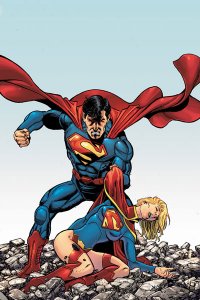
By D. S. Randlett
If there is any character in the DC Comics roster who the New 52 reboot was to benefit, it was Superman. The fact that he and Lois were married wasn’t so much the problem. The right creators can make that work quite well, actually. Rather, the problem was what the character had come to represent in the nineties and the aughts: a sort of wishy-washy inoffensive form of liberalism. At his very best, Superman provides a window into some of the crunchier aspects of human nature and experience, and his best stories revolve around dealing with the hurts of human life in an enlightened way. I understand that Superman has a political aspect which is rooted in the New Deal era, but those politics are the outgrowth of a certain view of the self in relation to society. The best Superman stories are about that conflict between self and state, and part of the appeal of the Superman fantasy is the ripping off of the mask of culture and the revelation of the true beating heart. In effect, Superman is able to make his world better by finding the truth within himself and making it tangible. When you have Superman walk across the country and complain about immigration policy, you’re basically turning him into a cable pundit.
Morrison’s current run on Action Comics has been interesting, but I can’t help but think that he’s forcing the stories that he wants to tell into the wrong title. The take on Superman’s early days as the world’s first superhero is actually emerging as a rather elegant distillation of the character’s history and various interpretations. Even though that arc is currently incomplete, Morrison’s themes are emerging rather clearly. We have a young radical using his abilities to right the wrongs that the system is either complicit in or powerless to prevent for our first four issues. The last page of issue 4 sort of telegraphs where Superman is headed from that point: his looking up to the sky at his next challenge evokes not only an external adversity, but also the challenge of growing outside one’s own prejudices. As clunky as Action Comics can be, and as much as some of Morrison’s indulgences can get in the way sometimes, he really understands why Superman matters.
So what about the “other” Superman book? In some ways, I wish that Superman was the book that Morrison was working on. His ambition to live up to the dictates of the Action title gets in the way of exploring Superman’s emotional context in the way that he’s clearly interested in. What Superman is at the close of it’s first arc is, like its cousin, a bit of a mixed bag. However, Superman lacks the insight into the title character that makes Action Comics an interesting read despite some of its failures.
For one, the art is very good. Jesus Merino has a good eye for action and detail, but I find myself looking forward to Nicola Scott’s work a bit more. She’s a better “actor” than Merino is. Scott is the best kind of superhero artist, able to convey action and energy, but also sentiment. Even though the writing team is changing next month, these artists seem to be sticking around, and that’s a good thing.
Perez’s writing… well, it’s very old school. This is no bad thing in and of itself, but it seems to counter the intent of the relaunch. The first issue of this series started off with a brooding Superman, which wasn’t too surprising. There had been hints that this was where Warners/DC wanted to take the character in order to make him more “relevant.” It wasn’t so bad, as Supes had his reasons. The Daily Planet had been sold off to a big NewsCorp-like entity, which was already exerting pressure on the Planet to change its editorial policies. That’s an interesting conflict, having Superman come up against something in his Clark Kent life that chafes against his mission. But then that story basically gets dropped for the rest of this first six issue arc.
What we got instead was a confusing story where some aliens who seem to have ties to Krypton are up to no good, going so far as to create an impostor Superman. So here in issue six, we have our showdown where Superman wakes up from some sort of forced stasis to figure everything out and put it right. Apparently, Superman’s broodiness was the result of alien nanites messing with his head, which I guess is something of a relief. This story’s big moment is Superman asserting himself over those feelings, because he knows that that’s not who he is. But that moment doesn’t really land the way that it should, because we have nothing to weigh his unusual behavior against. These past six months should have been spent introducing us to our “new” Superman, but we’ve really only seen an impostor or a Superman who wasn’t completely himself.
The core idea of this story isn’t a bad one at all, but it has so much to introduce in terms of the supporting cast that it never really lets us get to know this iteration of Superman on his own terms. Why should him being replaced by an impostor feel like a big deal to us? What we’re left with is a story that drags on for too long and has no impact. And it’s a shame, because Superman can matter, even today. Starting everything over may not have been wholly necessary, but it opens up a host of story possibilities for the character.
After six months, it would seem that DC doesn’t really know who Superman is yet.
Rating: 




Out of a Possible 5 Stars
 Too Much Coffee Man: Cutie Island OGN (Boom! Studios, $17.99)
Too Much Coffee Man: Cutie Island OGN (Boom! Studios, $17.99)By Bart Bishop
Anything with a quote from Henry Rollins on the back has to be good. In fact, Too Much Coffee Man may be my new favorite thing. Written and drawn by Eisner Award- winning and current New Yorker magazine cartoonist Shannon Wheeler, this new 189 page original graphic novel is comprised of six parts and an epilogue. Only the first segment deals with the titular character, while the others range from Wheeler’s personal experiences with life and creating an opera based on his famous comic strip to an island of cute but single-minded animals to a man that lives on the moon and rides a squid to work. Truly bizarre and surrealist work and not at all what I was expecting experiencing this creator’s work for the first time, but to say the least I was pleasantly surprised.
So Too Much Coffee Man started in 1990, and for years was self-published by Wheeler. The character has appeared in comic strips, minicomics, webcomics, comic books, magazines, books, and operas, and yet somehow I’ve missed out on this phenomena. This comic is, in fact, the first appearance of the long-underwear-clad hero on the printed page since appearing in the aforementioned opera that started in 2006. What’s funny is while depicting him as a superhero lends Too Much Coffee Man a sense of self-awareness of his medium, this isn’t a satire of superheroes. This graphic novel is a cynical meditation on loneliness and alienation in the 21st century. Without having read any of the earlier material, I’m going to assume Wheeler picked up on the zeitgeist of the Generation X crowd and ran with it, as this work feels so relevant and yet so timeless.
So Wheeler as a writer: this graphic novel has a sweeping sense of tone and scale. The first segment, “Too Much Coffee Man”, deals with the every day life of the protagonist. This is set up in comic strip form, which makes sense as Wheeler has been writing the character as an online strip for years. Most of the set up of each strip goes one or two ways: TMCM finds optimism, against all odds, and has his hopes diminished by a turn of fate or crushing epiphany in the last panel; or he starts off cynical and ends up even more cynical by the end. This pays off as a punchline, playing into Wheeler’s wonderful comic timing. It’s delicious schadenfreude, but horribly delicious as TMCM cannot win.
The second section, “Opera”, deals with Wheeler’s personal experiences with the strip in the last decade, and it becomes very obvious that the character is only an exaggerated version of the writer. This is a nice interlude, as it provides relatable ethos with the writer before completely switching gears with “Cutie Island”. The main character, a cute bunny, struggles with the slippery slope of living in, and maintaining, a utopia. It’s a wonderful commentary on the monotony of perfection, and the bullheaded stubbornness of the masses. “Ruminations”, “Balloon Boy”, and “A Boy and his Squid” devolve, not in quality, but into more nonsensical narratives that give Wheeler the opportunity to wax philosophical, but most importantly have beautiful artwork.
So the black & white artwork might be a little offputting at first. It lacks in detail and background, mostly functioning as caricature. Still, Wheeler’s expressions are so spot on and bittersweet, evoking the perfect note of mélange and despair while being so ridiculous it’s impossible not to laugh. There’s no standard tropes of beauty within these pages; everyone is round and small, trapped within the paneled boxes as they are within their lives. This leads to great fourth wall breaking moments, such as when TMCM is presented with multiple routes to get down from a mountain but ends up in the same place in the end, or during “Ruminations” when thought bubbles are used as weapons. Wheeler’s anecdotal social commentary, along with the subversive Seuss-esque poetry of Matt Speer during the “Ruminations” section is the kind of every day detritus we’ve all encountered, so much so that I wonder if TMCM is rattling around in my own subconscious, but this graphic novel offers up such a unique perspective as to close the book on complaints.
That’s right, put up the chairs and lock the door on the way out. You’ll never be able to complain as pointedly or as illuminatingly as Wheeler does here, so why even try?
Rating: 




Out of a Possible 5 Stars
Hector Umbra HC (Blank Slate Books, $26.99)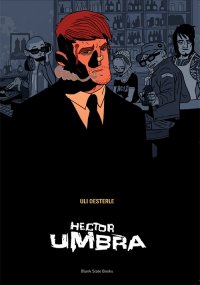
by Graig Kent
I remember thinking, a half decade back, while reading for the first time Kieron Gillen and Jamie McKelvie’s Phonogram, that the books’ conceit of “music is magic” could extend beyond its setting of the then-modern London club scene and the the lore of mid-90’s Brit Pop by franchising into other major music-and-culture centers. The Munich-set Hector Umbra isn’t so directly an extension of Phonogram‘s magic and music-nerd ideology, but it’s easy to look at it (perhaps with a bit of squinting) and draw a connecting line.
But I’m being unfair (or it would be unfair, if Phonogram weren’t such a phenomenal series to compare it to), as Hector Umbra is its own beast. A recently translated 216 page original graphic novel from German writer-artist Uli Oesterle, the book is part pulp detective mystery, part unseen enemy/alien invasion story, part ode to Munich, and part character drama. Oesterle negotiates these many and varied facets into a carefully paced, organically told adventure, building its atmosphere through equal focus on character, setting, and story.
The basic plot finds the titular character looking into the disappearance of his friend Osaka Best, the city’s premiere DJ, after disappears mid-set at a night club. Hector, already reeling from the accidental death of another friend, begins frantically poking about DJ Osaka’s life, discovering that his friend wasn’t all that he appeared to be, and in the process also discovering his city, and even his own life aren’t exactly what he thought they were.
The landscape of the book is varied and weird, but underplayed and somewhat self aware so as to keep the characters (and in turn the readers) invested. It includes “So Crazy”, an appalling man-on-the-street TV show exploiting the homeless and insane, steeped in equal amounts schadenfreude and irony for the hipster set, so unreal I’m sure somewhere an executive producer is trying to workshop it. There’s the omnipresence of Watchtower-carrying elderly Jehovah’s Witnesses who also happen to be judo masters. There’s a visit to a pub for the dead, as well as a glimpse at television in the afterlife, There’s invisible mutant alien mole people (that aren’t actually any of those things) with names like King Rock (he’s an Elvis aficionado) and Lego Bulosa (a not-quite-anagram of Bela Lugosi, I presume), with a nefarious plot to take over the world. In the middle of it all is Hector Umbra, getting punched in the face, tortured, and overwhelmed at every turn, struggling to make sense of it all like a true hardboiled hero. He’s a noble, complex guy whose recent experiences, and their ties to his past, find him maturing at an alarming rate. And then there’s Osaka’s music, which is in its own way magic, but also a weapon.
Osterle delivers a story that is off-beat and hip, weaving between sombre, sentimental and fun, like a romance-free, slacker-less Scott Pilgrim. The dialogue is natural, at times humorous but not precious. His art matches suit. From the cover I expected a Paul Grist feel, but on page 17 Oesterle ostensibly name checks his main artistic inspiration for the book with a visual shout out to 100 Bullets (alongside other thematic or visual inspirations like David Lapham’s Stray Bullets, Paul Pope, From Hell and a few European titles I’m not familiar with). Once you’re aware of the reference, Oesterle’s use of blacks, as well as his rounded, exaggerated characters keep recalling Eduardo Risso’s aesthetic time after time, but it’s more of an intentional affectation than a direct influence. I haven’t read any of Oesterle’s previous works (though this definitely makes me want to), but there are hints throughout of different, more animated, less gritty style, though a rich level of detail I imagine is a staple of his work. There’s a lot of love in his detailing of Munich’s streets, architecture and ambiance, and as much as it’s an engaging story, the scenic tour of Munich along the way makes it somewhat of a vacation as well.
This is the first of Oesterle’s works to be translated to English. Based on the strength of Hector Umbra, I hotly anticipate more.
Rating: 




Out of a Possible 5 Stars
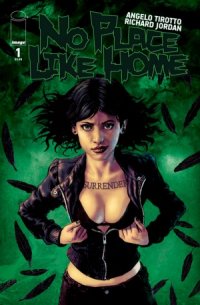 No Place Like Home #1 of 5 (Image, $2.99)
No Place Like Home #1 of 5 (Image, $2.99)
By Jeb D.
As familiar characters and stories drop from copyright protection, the “high-concept” reimagining of them has become quite the busy cottage industry (as well as becoming the source of an amusing lawsuit, where the estate of Edgar Rice Burroughs is claiming that Dynamite Comics is damaging the reputation of the John Carter series by depicting Dejah Thoris in the nude… you know, just like Burroughs wrote her). There’s a tricky balancing act, though: too much reliance on the original leaves a lot less room for creators to come up with something that stands on its own; on the other hand, too little association with the original and you’re in danger of drifting into irrelevance.
No Place Like Home is the latest venture into a version of L. Frank Baum’s Oz series (with at least one specific visual nod to the familiar 1939 film adaptation), and its opening pages, set in the summer of 2001, bring us the familiar sight of a tornado bearing down on the flat-plain farm community of… Emeraldsville? Well, putting aside that rather clumsy choice of name, we’re quickly shown that what writer Angelo Tirotto has in mind is not a quick recap or simple updating of the classic story… our first clue being that the terrified farm couple hiding from the storm are clearly afraid— not of the tornado, but of the coming of some evil entity that it evidently presages.
From there, we move to the introduction of our protagonist: Dee (that’s her on the cover showing off her impressive… assets). She’s a young woman who escaped her hick-town upbringings to move to L.A. (she’s so hip she’s seen the Yeah Yeah Yeah’s a full two years before their first album came out) and has brought her sassy, newly-uptowned self back for the funeral of her parents: the unfortunate couple who died in the tornado. Well, as the alert reader already knows, things are not as simple as Dee had thought, a point driven home by the slobbering homeless lunatic whose mad ravings try to warn her to leave town, and who berates the townspeople about their shameful knowledge of what happened the last time this storm appeared (which, since all the characters already know what he’s talking about, Tirotto doesn’t have to share with us just yet). It’s a briskly plotted first issue, though considering that each character basically fills one of two roles (either “confidant” or “hider of guilty secrets”), the talkiness feels a bit repetitive and the exposition sometimes gets troweled on. Hopefully, the fact that we’re jumping right into the thick of the horror is an indication that Tirotto has a lot more twists to reveal.
It’s obviously too early to have a definitive opinion about the story’s mysteries, but one aspect gives me pause: the decision to set the story in the year 2001. Now, there are two things that year brings to mind, and since I don’t think that the Kubrick film is being referenced here, that kinda leaves the other one, which strikes me as a needless distraction, and one that is very often handled clumsily; so let’s hope I’m wrong. Apart from that, Tirotto’s pacing seems just right: structuring the first issue of a comic miniseries is a delicate business: you need to hold back enough story to fill the remainder of the book, while providing enough that the reader is encouraged to come back for more; so far so good.
The art, by Richard Jordan, is for the most part, excellent. It’s certainly not what you associate with an Oz-based property: it has some of the fleshiness and darkness of someone like Juan Jose Ryp or Darick Robertson, with dread hanging over everything. For some readers, it may be a drawback that this screams “horror comic!” from the first panel, but Tirotto isn’t dealing in subtleties here, so why not go all-in with the doom and fear from page one? Paul Little’s color palette is appropriately gloomy (even the sky in Emeraldsville seems to be more a sickly pea-soup green than any shade of blue or grey you’ve ever seen), and the static layout of the panels lends a slight air of claustrophobic disquiet.
Of course, the other thing that’s too early to know is whether this story is going to offer some interesting perspective, or even clever riffing, on its source material, or if it’s just invoking Oz as a readership hook. Ultimately, though, if Tirroto can make the mystery pay off, and do so in such a way as to justify Dee’s continuing adventures (which he indicates to be his plan), that will be a secondary consideration… so long as nobody from Frank Baum’s family objects to “Dorothy”‘s cleavage.
Rating: 




Out of a Possible 5 Stars
The Massive parts 1 & 2, from the pages of Dark Horse Presents (Dark Horse, $7.99)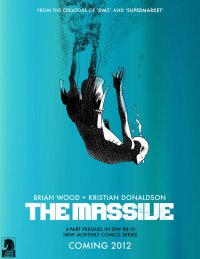
By D. S. Randlett
It’s easy to be skeptical of anthology titles in America. For too long, such collections have been a haven for work that neither publishers nor creators are entirely confident in. For an American publisher, Dark Horse seems to have things backwards. They’ve got their money titles like Star Wars, Mass Effect, Conan, and the like, but DHP seems to be their top flight title debuting original work by several top flight creators. Which brings us to Brian Wood, who debuted his three-part strip, The Massive, last month.
Wood is one of the most intelligent, ambitious, and honest writers in comics today. Even when his work doesn’t fully succeed (see the pretty-good-but-not superlative Conan The Barbarian), there almost always something in his his scripts that intends to provoke. He rarely phones it in, and this makes him worth following.
The Massive is built on an interesting concept: what happens to an environmentalist when the environment has won, when there’s nothing left to fight for? You wouldn’t know this from these two parts of this story. Strangely enough, this isn’t a bad thing at all. The two current entries of this strip focus on two separate characters, telling stories that happen before the apocalyptic world that the third and final entry in this series will likely inhabit. As such, these two entries function as different meditations on different aspects of nature through the eyes of two different characters. For one, nature is an awesome Old Testament power that must be heeded. For another, nature is a loving provider that must be protected. For their shortness, these entries are rich in character and pathos, and may be some of the best pages of Brian Wood’s career.
Wood has signaled an interest in turning this concept into an ongoing-ish series. As of now, that is a wish that I share. If Wood can translate the richness of character found in these brief pages into a series, we may be looking at the next great comic book. But the story starts here, even if it starts briefly, a gem collected among gems.
Rating: 




Out of a Possible 5 Stars
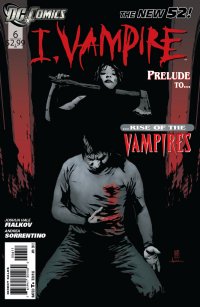 I Vampire #6 (DC Comics, $2.99)
I Vampire #6 (DC Comics, $2.99)
by Graig Kent
Thanks to the proliferation of the “romantic vampire” series like True Blood and Vampire Diaries, as well as the earlier “action vampire” trend via Blade and Angel, and the modern tendency to monster-size them by creating “new breeds”, the old bloodsuckers altogether just aren’t that scary anymore. The Twilight phenomenon is pretty much the stake through the heart that threatens to ruin vampires for a whole generation, with sheer overexposure being the sunlight that will burn them to ashes.
It’s from these ashes that I, Vampire, the most unheralded, unwanted and flat-out surprising series of DC’s entire “New 52” line rises. Situated smack in the middle of a mainstream superhero universe is probably the last place someone would think to look for one of the best vampire stories of this young century but there it is. It’s a great book, which is definitely underselling it.
What makes I, Vampire stand out from its fanged brethren is its use of vampire folklore. Unlike so many other books, it doesn’t write out all the abilities of a vampire, like turning into rats, bats, wolves or fog, nor does it ignore the fact that vampirism can be reversed if you kill the sire. Of course, the book establishes its own rules for its playground, but it does so strategically and effectively. It also embraces the romantic and the action hero facets alongside the horror of the sub-genre, throwing nothing away. It’s oddly one of the most traditional — brooding and gothic — vampire stories I’ve read, yet still very modern.
Leading up to this sixth issue, writer Joshua Hale Fialkov has assembled a small team around his heroic/tragic lead, the reformed, ages-old vampire Andrew Bennett, as he hunts his true love (and arch nemesis) Mary, Queen of Blood, battling through her hordes as she ups the ante on her species war against humanity. There’s Bennett’s long-time friend/vampire hunter Professor John Troughton, Tig Rafelson, wary stray whom they’ve picked up along the way, and Batman. Yes, Batman.
You wouldn’t know it from the cover (which surprisingly keeps its guest-star to itself), but Batman is a supporting character in Bennett’s war with Mary as it culminates in Gotham. Fialkov uses Batman strategically and brilliantly, as he engages in combat with the bloodsuckers but holds back from destroying the creatures, while Tig and John aim to stake and behead them. Andrew himself resists killing, noting that if he kills their sire then most of their enemies will be freed of their curse. When Batman confronts Mary, his aim is justice, as he tries to apprehend her, noting that he’ll let “Zatanna sort this out”. Especially since Buffy The Vampire Slayer, we’ve become so accustomed to the idea of “dusting vamps” with little to no thought of the humanity that may linger beneath, that it’s a potent moment to think Batman weak, rather than heroic, for his inability to kill them. He of course was kind of right not to, and yet, when he interferes with Andrew’s attack against the the sire, he’s also so very wrong. It’s a delicious complexity in Fialkov’s script that benefits from being in a superhero universe and using such a well established, moral character like Batman.
While I won’t spoil the surprise, for all his little victories, Andrew Bennett loses, rather direly, his war against the Queen of Blood. We will typically see a protagonist enter a situation that looks pretty hopeless, or get into a jam that seems virtually inescapable, but somehow they always escape. I honestly don’t know how Andrew’s going to get out of this one. It’s shocking.
Artist Andrea Sorrentino is coming out from under all those Jae Lee comparisons and into his own, and this issue is a tour de force. While still growing as a storyteller, with the occasionally awkward scene that takes a moment or two to understand what’s being presented, Sorrentino’s opening pages are furious and intense with that quasi 2-page spread on pages 2 and 3 being completely unsettling. Throughout the book the panels are uniquely laid out and captivating, with a keen use of white space contrasting against the black, red, grey and brown color washing of Macelo Maiolo. It’s a strikingly visual experience.
I was thinking recently about how unfortunate it was that the “New 52” were already launching into team-ups and cross-overs and mini-events, seemingly to the detriment of establishing each individual title. Next month, the arc that Fialkov has built in I, Vampire spills over into Justice League Dark, and, just like Batman’s appearance in this title the past two months, it seems like a natural fit in a shared universe, and even more so given the events of this issue. This is a book worthy of attention, the darkest gem in DC’s lineup, and this issue is the best yet.
Rating: 




Out of a Possible 5 Stars